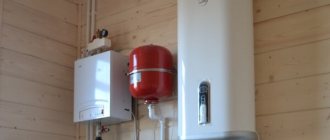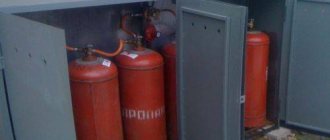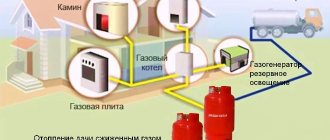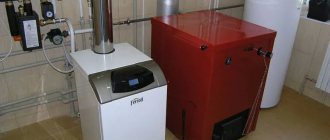If it is not possible to connect to the gas line or there are large construction costs ahead, but there is no extra money, there is a completely workable option. Heating a house with electricity, although not the cheapest, does not require such impressive costs as gasification. Electrical networks are available almost everywhere, so sometimes it’s easier to use the available opportunities.
Advantages of electric heating
Many people choose electrical appliances as a heat source even if there is a gas main, since such heating has certain positive aspects:
- easy to install;
- does not make noise;
- easy to use;
- does not require the installation of chimneys to remove combustion products.
Connecting electricity is much cheaper and easier. Today, the cost of gasifying a house is approximately 300 thousand rubles, which in conditions of unfinished construction can be a determining factor. And many gardening associations, where residents are now allowed to legally reside, are not getting gasification even in the distant future.
When installing electric heating, you need to be prepared for the fact that utility bills will be rather high, since electricity is a derivative of other types of fuel (oil, gas, coal or nuclear materials). Some inconveniences can be caused by voltage fluctuations in the network or frequent power outages. Therefore, when connecting electric heaters or boilers, it is recommended to immediately install a stabilizer and generator.
Some boilers operate on three-phase 380V, which requires a permit. Maximum measures must be taken to prevent electric shock, and high-quality working grounding must be installed.
Choosing a double-circuit electric boiler
To select a boiler that suits the technical characteristics of the house and meets the needs of the owners, they determine the required power, the manufacturer’s brand, and then select boiler equipment in an affordable price category.
What power does the boiler need - let’s do the calculation
The procedure for calculating an electric double-circuit boiler includes the need to calculate the total power sufficient separately for heating and hot water supply:
- The performance of a 2-circuit electric heating boiler, sufficient for heating residential premises, is calculated using the formula 1 kW = 10 m2. About 15% of the reserve is added to the result obtained.
- Next, the DHW calculation is carried out - for classic double-circuit electric mounted heating and hot water supply boilers operating in flow-through water heating mode, about 15-20% is added to the calculated power + reserve.
- When calculating a boiler with a built-in boiler, they are guided by the manufacturer’s recommendations and the power indicators indicated by him, sufficient for heating water and heating.
The calculations touch on another area related to the amount of electricity consumed. Manufacturers, depending on energy consumption, produce two basic models of electric heaters: single-phase and three-phase.
The first, single-phase, are produced with a power of up to 8 kW and are connected to a 220V network. In the technical documentation, single-phase boilers are classified as conventional water heaters (boilers), therefore, when connecting, they do not require additional permits and the allocation of a separate voltage branch.
If the power consumption exceeds 8 kW, install a three-phase boiler. Connection to the electrical network is carried out via a separate 380V branch. If the line is not connected to the house, a request is made to increase energy consumption.
Main manufacturers - who to choose
European companies remain leaders in the production of double-circuit boilers. The models offered by the concerns are characterized by high efficiency, safety and reliability of assembly. The design uses the latest technologies to protect the heater from scale and prevent failure during voltage surges.
Domestic electric boilers with two circuits deserve special mention. The products of Russian companies are fully adapted to operating conditions. Although the boilers are inferior in functionality to foreign analogues, they are not inferior in reliability and performance, and in some cases even surpass the latter.
There are several models that are in constant demand among consumers:
- Russia:
- EVAN Ecowatti,
- Savitr Premium.
ThermoStyle EPN,
- ACV E-tech S,
Wespe Heizung Kombi,
Most of these models are presented in the premium class and use energy-saving technologies in their work.
Prices for electric boilers with two circuits
The cost of a 2-circuit electric boiler depends on several factors:
- Options.
- Manufacturer and place of assembly.
- Productivity.
Premium domestic electric boiler, offered starting from 20 thousand rubles. The basic model of a European brand will cost 1.5-2 times more. Prices start from 30 thousand rubles. and higher.
Pros and cons of double-circuit electric boilers
Reviews from owners about 2-circuit electric boilers show that equipment of this type is not popular. The most commonly used scheme is a single-circuit boiler and an external boiler. The solution increases the efficiency level of the boiler and its energy efficiency. Electricity costs, compared to double-circuit electric boilers, are reduced by 15-20%.
Despite the existing disadvantages, double-circuit boilers are in certain demand. Judging by the statistics, they are installed when connecting autonomous heating and hot supply to a small apartment. Small size and the ability to obtain hot water without installing additional equipment are the main advantages and advantages of this design, ensuring the necessary popularity.
Types of electric heating systems
To heat a residential building the following can be used:
- fan heaters;
- convectors;
- oil radiators;
- infrared emitters;
- heated floors (made of heating cables or films);
- stone heaters;
- electric boilers with water circuit.
Equipment for heating a house with electricity varies in design, method of energy conversion and, of course, price.
Fan heaters
Inexpensive and easy to use devices quickly warm the room. They operate on a voltage of 220 V, that is, from a regular outlet. Inside the case there is a heating element made of metal or ceramic and a fan. Thanks to the heat injection, all parts of the room are heated evenly. Disadvantages: noise, dry air, which can cause headaches in sensitive people.
Fan heaters are used to heat rooms up to 20 m². They are indispensable for short-term stays in the house or as an additional source of heat when other types of heating are ineffective. The temperature is adjusted manually, so this method is not the most economical or comfortable.
Convectors
Convenient, safe and reliable heaters can be used to heat a private home with electricity without restrictions. Heat is transferred by convection, which makes them similar to conventional water radiators.
Convectors are installed on the floor or attached to the wall with brackets. There is a heating element inside the metal case. Cold air masses enter from below, move upward and exit through the grille already warm.
A thermostat is provided to regulate heating. The most economical convectors are those with inverter control units equipped with highly sensitive sensors. They respond to temperature changes, maintaining comfortable conditions. More expensive devices can operate in a programmable mode and start on command at the right time.
The power of the convector is selected based on the area of the room - 1 kW is designed for 10-12 m². Most heaters have a power of up to 2 kW, so for large rooms one heater will not be enough.
Convectors operate silently. They can be left in a cold room without the risk of freezing. If children live in the house, when purchasing, you need to pay attention to whether the design includes protective measures.
Oil radiators
The heater consists of a steel body with a heating element and a container with mineral oil. When connected to the network, the liquid begins to heat up, which transfers heat to the surface of the radiator. Air temperature rises due to convection and radiation.
Each radiator produces a certain power and is designed to heat one room. It can be moved to any place using wheels. Control is carried out via a mechanical thermostat.
Oil devices are safe. The heating elements are located inside, and if it tips over, the protection is triggered. In addition, the surface is quite smooth, without grooves, holes or grates, so the devices are easy to care for.
Infrared heaters
The air in the room where IR emitters operate is heated not directly, but from other surfaces. Infrared radiation emanating from heaters first heats surrounding objects, and only then the heat is transferred to the air.
Electric IR heaters use tubular heating elements or spirals in quartz tubes. The inside of the reflector body is coated with heat-reflecting material to give the radiation a specific direction. To protect against contact with the heating element, a mesh or transparent partition is attached to the device.
Infrared heaters can be ceiling, wall or floor mounted. They are also produced in the form of PLEN films, which are a flexible sheet with or without a decorative pattern applied to the surface. Inside there are thin strips of carbon - synthetic carbon fiber, capable of heating up to 55°C when current passes. Heat is transferred to aluminum foil, which has high thermal conductivity and reflective qualities. Thus, electrical energy is converted into thermal energy and then into radiant energy.
Film heaters are very light and thin. They can even be hung on the door. After switching off, the heat remains in the room for a long time. Many note that it is more comfortable and enveloping than from convectors or radiators.
Electric heated floors
The "warm floor" heating system is recognized as the most economical way to heat rooms. When using it, it is possible to reduce energy consumption by 20% compared to convective heaters.
The location of the heating layer in the floor allows you to maintain a comfortable temperature in the lower part of the room, where a person lives almost all the time. The heat is distributed evenly, so there are no cold spots. Due to the fact that the heaters are integrated into the screed or hidden under the floor covering, the space remains as free as possible.
Electric heated floors can be installed:
- from heating cables;
- heating mats;
- infrared film.
The cables are laid in a spiral or snake on top of the insulation. A concrete screed is placed on top, protecting the conductor from damage and acting as a heat accumulator. After the base has dried, you can lay tiles - the best finishing material for heated floors. It is heat resistant and conducts heat well. But this is not the only floor covering. There are special types of laminate and linoleum that are not afraid of temperature.
Thermomats are ready-made modules for installing heated floors. They can be cut while keeping the conductor intact. They are not laid in a screed, but in tile adhesive. A layer of a few mm is enough, which saves materials and does not reduce the height of the room.
Film floors can only be installed in dry rooms, since PLEN is sensitive to moisture. There is one more restriction - large items cannot be placed on the floor. Heat is transferred by radiation, and furniture or equipment located closely will be subject to local overheating.
Film flooring does not fit under tiles. Since its surface is smooth, the adhesion between the materials will not be strong. It is recommended to use laminate, linoleum or carpet, which do not require gluing to the base and do not interfere with radiation.
The temperature of electric floors is set by a thermostat. It is possible to use programmable regulators that can reduce energy consumption by several times.
Stone heaters
This is still a new product in Russia, but soon it may very well replace standard metal radiators and convectors. The heating element in stone heaters is surrounded by a durable shell of quartzite-sandstone, limestone or marble, which have high heat transfer and heat capacity.
According to scientific research, radiated heat is extremely beneficial for health. The wavelength of the radiation corresponds to the wavelength emanating from the human body. The air is ionized due to the release of the quartz component.
A power of 500 Watts is enough to heat a room of 10-30 m². A plus is the modern design in eco-style. Considering that electricity consumption is very economical, and the warranty period is 20 years or more, we can say that masonry heaters are the future.
Reviews on electric boilers for a house 100 m2
And now a couple of reviews on electric boilers for heating 100m2 houses from different readers from different regions:
Vladimir Batutin, Moscow region: House 105 sq.m., timber 20 cm, ceiling 15 cm basalt wool, floor 10 cm foam. I use a 12 kW Warmos boiler. Often you have to press down the radiators with their heads, it’s a bit hot. And winters have been getting warmer and warmer lately.
And here is another review on electric heat generators for such an area:
Sergey Averin, Yekaterinburg: I have a box made of warm blocks, the wall thickness is 40 cm. The ceilings are insulated with stone wool. The Rusnit boiler is rated at 9 kW. This is enough for my 100 squares. When there are frosts of -40C (there was such a week last year), I heat the house with a Butakov Engineer wood-burning stove.
Well, well, so we looked at the question of which electric boiler is better for heating a private house of 100 m2 from different sides.
I hope you now have an understanding of what parameters to choose this equipment by, what to include in the package, what type of heating unit to choose.
And yes, write comments at the bottom of the page - your reviews and questions about boilers.
More on this topic on our website:
- Electric boiler for heating a house of 30 m2. Is an electric boiler suitable for heating a private house of 30 m2 of area? Are such boilers available for sale? How effective will it be...
- Electric boilers for heating a home - reviews and electricity consumption So, colleagues, today we are looking at what reviews there are on electric boilers for heating a private home. Electricity consumption and how...
- Electric boiler for heating a house of 50 m2 So, colleagues, today we have a question on our agenda - which electric boiler to choose for heating a private house of 50 m2...
- Electric boiler for heating a house of 150 m2 When choosing an electric boiler for heating a private house of 150 m2, you should focus on 4 main parameters that affect…
Electric boilers: operating principle and types
For constant heating of a residential building, a boiler with a liquid circuit is most often used. The classic model consists of a heat exchanger with heating elements, a safety group, an expansion tank, a pump, automation, and a control unit. The heated coolant is pumped into the heating system and releases energy to the radiators, then returns back.
Circulation occurs constantly. When the heating is turned off, the coolant remains in the pipes. If the equipment is used for hot water supply, an indirect heating boiler is provided.
The efficiency of electric boilers is very high - up to 95-99%. This means that almost all energy is converted into heat and there are almost no losses. Heating of the coolant (water or antifreeze) is carried out by heating elements, electrodes or induction coils.
Heating elements new boilers
Inexpensive, but less productive than others. The coolant is heated by a heating element, which is carefully insulated for safety and placed in a sealed housing. This increases energy loss and reduces power. In addition, due to poor-quality coolant, insoluble salts are deposited on the heating elements, which leads to the failure of the heating element. To change it, you need to turn off the heating and drain the water or antifreeze.
Electrode
They are ion-type heaters and do not contain heating elements in their design. Electric current flowing from the anode to the cathode heats the coolant due to the high electrical resistance of the liquid. The heating efficiency is determined by the properties of the coolant.
Manufacturers claim that ion boilers consume 50% less energy than traditional heat generators with tubular heaters. They can be used as primary or backup equipment, connected in a cascade or sequential manner.
The power during operation gradually increases as the coolant temperature rises. The boilers are equipped with mechanical or electronic automation. GSM modules and room thermostats also help save energy.
Induction
Heating of the coolant can cause not only a passing electric current, but also an electromagnetic field. To raise the temperature, a coil with a conductor connected to an alternating current network is used.
Due to the absence of heating elements, scale does not form even in unprepared coolant. The boiler efficiency can reach 99%, and the service life is 30 years. The coil is completely insulated, so induction boilers are absolutely safe.
How does a double-circuit electric boiler work?
The operating principle of a double-circuit electric heating and hot water boiler can be described as follows:
- The housing contains a tubular heating element (TEN). When an electric current passes, the inner spiral heats up. The heat obtained as a result of heating is transferred to the heating surface in contact with the coolant.
- Heat is transferred from the surface of the heating element to the coolant through natural or forced circulation of liquid in the heating system. The coolant enters a container with an electric heater, passing through which it comes into contact with the heated surface and accumulates heat.
- The heated liquid enters the heating system, releasing heat through radiators or heated floors.
The DHW and heating circuits operate in almost identical ways. When you open a hot water tap, the heating element turns on and begins to heat the liquid in a flow-through manner.
Double-circuit energy-saving electric heating boilers have a built-in storage tank - a boiler. The heated water is stored in a storage tank, with heat loss not exceeding 1°C per few hours. After opening the tap, hot water is immediately supplied to the consumer. The savings achieved thanks to the built-in storage capacity reach 10-15%.
Modern household double-circuit electric boilers of many European companies are created taking into account the connection to low-temperature heating systems - “warm floors”, without the need to install additional equipment.
Electric boilers are available in wall-mounted and floor-mounted (stationary) versions.
Mounted 2-circuit electric boilers
Floor-standing electric boilers with two circuits
Installation of a double-circuit boiler in a floor-mounted design is justified for providing heat to a private home or cottage. More powerful devices than their wall-mounted counterparts do a good job of heating living spaces and preparing sufficient quantities of hot water.
Double-circuit floor-standing electric boilers take up a lot of usable space. They are produced with a minimum output of 10-18 kW (depending on the chosen manufacturer), therefore, they are mainly used in private houses or cottages.
High productivity in the design of floor-standing boilers is combined with a built-in storage tank (not present in all models), automation and high DHW throughput. Solutions with the additional connection of an external heat accumulator are popular, which allows saving on electricity by at least 25-30%.
The essence of the solution comes down to the fact that a connection is made to a three-tariff meter. The boiler operates at full capacity only at night, when electricity is available at a reduced price. During this time, the heated water enters the heat accumulator. During the daytime, the boiler turns off.
The coolant is heated using previously stored heat. The solution is optimally suited for low-temperature heating systems.
How to make heating cheaper
Even the most modern and economical equipment will waste energy if the house is not insulated. Thermal insulation is required not only for walls, but also for the foundation, plinth, roof, and openings. The thickness of the insulation should be calculated taking into account the climatic zone and all layers that make up the enclosing structure. Entrance doors with a thermal break, double-glazed windows, insulated floors on the ground - all this will save the lion's share of electricity and not heat the street at your own expense.
If you solve the problem in a comprehensive manner, you can achieve very good results. To do this you need:
- Have a power allocated to the house of at least 15 kW. If it is insufficient, it will not be possible to save energy. The equipment will turn on and off frequently, resulting in excessive current consumption.
- Design and install an economical low-temperature heating system. It is necessary to calculate the power of radiators, install thermostatic heads and temperature sensors.
- Use a heat accumulator. At night, it will accumulate thermal energy, and during the day it will compensate for its lack.
In houses that cannot be gasified, the electricity tariff is significantly lower. The state provides social support so that residents can use cheap heating with electricity and satisfy their household needs without much damage to the family budget.
Almost all regions have a tariff program. This means that from 7 am to 11 pm the prices are high, and at night they are 2-4 times lower. To use tariffing, you must install a two-tariff meter. Since the single tariff does not differentiate energy consumption by time, but only displays the total consumption, you will not be able to take advantage of economical electricity.
Cost of electricity in the kitchen
If you don't have gas, you'll have to cook with electricity. Modern electric stoves are highly efficient, but they also consume 5 to 7 kilowatts of electricity per hour at full power.
A modern kitchen, even with a powerful stove, does not consume much electricity.
The approximate cost of cooking with electricity will be from 300 to 500 rubles per month, regardless of the size of your home.
Electric heating system for a country house using a heat accumulator
A heat accumulator is a buffer tank that can significantly reduce the cost of heating a home. It is made of stainless or carbon steel and is wrapped with thermal insulation to reduce heat loss.
The water is heated using heating elements to a temperature of 90-95° using cheap night electricity. During the day, the time relay is triggered and turns off the energy supply to the heating elements. Heating of the premises occurs due to hot coolant from the tank. The heating system portions out water from the heat accumulator in the amount required at a particular moment.
An electric boiler can be used as a backup heat source. If the temperature of the coolant in the storage tank becomes insufficient to replenish heat loss, the boiler is started from the thermostat command to the built-in servo drive. Then the water is redirected not through the tank, but through the boiler.
If there is a problem with the heating elements, the backup heater will take on the entire load. This increases the reliability of the heating system.
If the house uses radiator heating and a “warm floor” system, 2 collectors for each type of heating are included in the boiler piping. Then each mixing unit can be adjusted and the optimal mode can be set. In the radiator network, the coolant temperature must be at least 70°C, while for heated floors 40-50°C is sufficient. Therefore, the boiler will consume the power that is necessary to heat each branch.
The desired temperature values can be set using servo drives. Thermostatic heads installed on radiators will help to additionally save heat without sacrificing comfort.
There is another way to reduce energy consumption, but it does not involve creating comfortable conditions. The boiler operates at high power all night, and during the day it either turns off completely or is set to minimum heating. In the morning the house will be hot, and by evening it will be much colder. Savings will be achieved, but the price is not acceptable for everyone.
Dependence of the cost of heating on the building materials used
Thermal conductivity is the property of building materials to conduct (give off) heat from heated objects to colder ones. The faster a building material gives off heat, the colder it is.
A porous building material (foam block), the pores of which are filled with air, is capable of minimal heat loss. Therefore, foam blocks are considered the best heat insulators. A house built from foam blocks will always be warm. Accordingly, heating costs will be reduced.
The dense fibrous structure of building materials (wood, timber) retains heat well and releases it slowly. Wood is considered a warm material. But the enemy of wood is moisture. Wood absorbs moisture well, and wet timber quickly loses heat. To retain heat in a wooden house (made of timber), reliable external thermal and waterproofing is required.
Brick and reinforced concrete are considered cold building materials in terms of thermal conductivity, so brick and reinforced concrete houses require high heating costs. From all of the above, we can conclude that the thermal conductivity of the building material from which the house is built directly affects the cost of heating.
How to choose the boiler power and the volume of the heat accumulator
Typically, a buffer tank is installed together with a solid fuel boiler. This reduces the load on the boiler and promotes more uniform heating of the rooms. In addition, residents of the house do not need to constantly monitor the availability of fuel and work around the clock as stokers.
The heat accumulator is effective not only in heating systems with a solid fuel boiler, but also with any other ones - diesel, pellet and electric. By correctly calculating its volume, you can switch completely to cheap nighttime energy.
Two criteria for selecting a heat accumulator are boiler power and heated area. Typically, the boiler power is selected based on the area of the house. For every 10 m², the boiler must generate 1 kW of thermal power with a margin of 20%, that is, to heat a house of 100 sq.m, you will need equipment with a capacity of 12 kW, for 200 sq.m - 24 kW.
The tank volume is selected at the rate of 35-50 liters per 1 kW of boiler power. This means that in the first case the heat accumulator should have a volume of 420-600 liters, in the second - 840-1200 liters. With average insulation of the house, this is quite enough to warm the coolant with night electricity and use this energy during the day for heating.
Reducing the volume is undesirable; it will not give the expected economic effect. Increasing, on the contrary, reduces energy consumption. But here you need to take into account the weight of the water tank, the possibility of installing it indoors and, of course, the cost.
The price of a heat accumulator depends on the volume and material from which it is made. A black steel tank can be bought for 45-110 thousand rubles, a stainless steel tank for 65-210 thousand rubles. Installation and wiring will cost about 25-30 thousand. You can make a heat accumulator with your own hands, it will be much cheaper.
When changing the type of fuel, the tank can be connected to another boiler - classic solid fuel, diesel or pellet. There is no need to change the entire heating system. In order to have hot water supply in addition to heating, combined buffer tanks are produced.
Double-circuit electric boiler
Heating boilers powered by electricity are successfully used to heat cottages outside the city and houses in summer cottages. They have proven their performance, reliability and modest size. But for housing outside the city, it is important to have a hot water supply. In this case, a double-circuit electric boiler comes to the rescue.
This unit replaces the work of an entire boiler room and can be wall-mounted or floor-mounted. Its connection is possible to a network with one phase or three phases. Some samples are made with two electrical circuits for connecting heating elements - 220 and 380 V. You can buy electric double-circuit heating boilers in.
Choosing the most profitable home heating
Every developer dreams of having an economical system for their own private home. You need to understand that you can save on 3 key things:
- Financial
- Savings in terms of heating system
- Savings in terms of modern technology
Therefore, before installing heating you need to decide:
- For what purposes will the house be used? Will you live there permanently or visit periodically? The payback period of the heating system directly depends on this.
- What is key for you: saving on heating now or investing in the heating of a private home for the future.
- Decide which fuel will perform the key function
Possibilities for increasing the efficiency of heating with electricity
Despite the fact that today utility tariffs continue to increase, electricity has a strong margin in cost compared to other types of energy. Residents of apartment buildings who want to become independent and independent from central heating should not be afraid of high costs. Proper calculation of the heating scheme and connection of electric heating devices, the transition to multi-tariff meters will allow you to get the necessary heat in your home and regularly save on electricity costs.
If there is no technical possibility, installing gas or electric heating will be a real way out of the current situation.
Saving on finances
Let's remember right away: by saving money, you will never get the most economical heating for a private home. This is the main mistake of all developers. You invest money in building a big house (often), decorating the outside and inside, but most often you forget about such fundamental things as heating.
And heating costs money, and quite a lot of it. But despite all this, you can still save money wisely. You can simply install the good old and proven gravity radiator heating system.
It will be affordable and you will provide your home with warmth during the cold season. But I emphasize - this will not be the most economical heating system. More likely saved.











